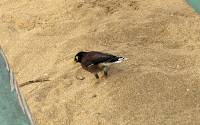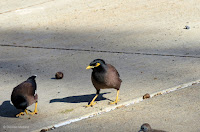COMMON MYNAH
COMMON MYNAH (Acridotheres tristis) – (See images below)
DESCRIPTION: The Common mynah is mostly brown with a black head, with a yellow bill and yellow legs, and a yellow bar under and behind the eye. When searching for food on the ground, this bird hops while walking. The bird measures around 9 inches long (22 cm). Both sexes are similar.
VOICE: https://www.xeno-canto.org/species/Acridotheres-tristis – This bird sings while preening (see video below).
NAME: Mynahs are part of the same family (Sturnidae) as the starlings. The English name is from Indian and refers to any starling of the Indian subcontinent. The Latin name is from ancient Greek and means ‘locust’ (akridos) and ‘hunter’ (theras); as for ‘tristis’, which means ‘sad’ in Latin, it is rather a misnomer as this bird sings well, and not sad tunes.
HABITAT: Common mynahs are widespread on the islands of Hawaii
DIET: This bird is omnivorous and will feed on insects, fruit, small reptiles and even carrion.
NESTING: The nest is usually built in natural or man-made cavities and is a loose structure of sticks and other various materials. Between two and six blue-green eggs are laid, incubated by both parents. Chicks also fed by both parents.
DISTRIBUTION: Native to India, this species is now spreading at such a pace that it is now listed as one of the worst species to threaten biodiversity and agriculture. It was introduced to Hawaii in the 1860s to control insect pests.
CONSERVATION: In many places where it was introduced, the common mynah is now considered as an ‘invasive’ and a ‘nuisance’ species for its facility at occupying new territory, damaging buildings where it nests, and displacing native bird species. On the other hand, it is also in demand as a pet and the pet trade (legal and not) puts pressure on the species in its native habitat.
ROOSTING: Common mynahs are very verbal social birds. Their calls can be heard at night when they roost by the hundreds in large trees before finally falling silent (hear video below right in the middle of Waikiki). Management on some high-rise condos in Waikiki are regularly pruning (photo below) those trees to prevent the birds from roosting there, as their ‘communal noise’ can be annoying for the residents.
REFERENCES: http://www.oiseaux-birds.com/card-common-myna.html
https://en.wikipedia.org/wiki/Common_myna
http://www.birdsinbackyards.net/species/Sturnus-tristis
https://identify.whatbird.com/obj/982/overview/Common_Myna.aspx
http://kuwaitbirds.org/birds/common-myna
http://www.nzbirdsonline.org.nz/species/common-myna
The common mynah has a peculiar gait. Adding this to the yellow bar behind the eye gives it a unique look:
Common mynahs will sing while preening:
In this video below you can hear the 'communal noise' of hundreds of common mynahs roosting for the night in trees by a high-rise condo in Waikiki after sunset:
Following a rain, water collects in puddles on lawns, becoming a great source of drinking and bathing water for birds:
DESCRIPTION: The Common mynah is mostly brown with a black head, with a yellow bill and yellow legs, and a yellow bar under and behind the eye. When searching for food on the ground, this bird hops while walking. The bird measures around 9 inches long (22 cm). Both sexes are similar.
VOICE: https://www.xeno-canto.org/species/Acridotheres-tristis – This bird sings while preening (see video below).
NAME: Mynahs are part of the same family (Sturnidae) as the starlings. The English name is from Indian and refers to any starling of the Indian subcontinent. The Latin name is from ancient Greek and means ‘locust’ (akridos) and ‘hunter’ (theras); as for ‘tristis’, which means ‘sad’ in Latin, it is rather a misnomer as this bird sings well, and not sad tunes.
HABITAT: Common mynahs are widespread on the islands of Hawaii
DIET: This bird is omnivorous and will feed on insects, fruit, small reptiles and even carrion.
NESTING: The nest is usually built in natural or man-made cavities and is a loose structure of sticks and other various materials. Between two and six blue-green eggs are laid, incubated by both parents. Chicks also fed by both parents.
DISTRIBUTION: Native to India, this species is now spreading at such a pace that it is now listed as one of the worst species to threaten biodiversity and agriculture. It was introduced to Hawaii in the 1860s to control insect pests.
CONSERVATION: In many places where it was introduced, the common mynah is now considered as an ‘invasive’ and a ‘nuisance’ species for its facility at occupying new territory, damaging buildings where it nests, and displacing native bird species. On the other hand, it is also in demand as a pet and the pet trade (legal and not) puts pressure on the species in its native habitat.
ROOSTING: Common mynahs are very verbal social birds. Their calls can be heard at night when they roost by the hundreds in large trees before finally falling silent (hear video below right in the middle of Waikiki). Management on some high-rise condos in Waikiki are regularly pruning (photo below) those trees to prevent the birds from roosting there, as their ‘communal noise’ can be annoying for the residents.
REFERENCES: http://www.oiseaux-birds.com/card-common-myna.html
https://en.wikipedia.org/wiki/Common_myna
http://www.birdsinbackyards.net/species/Sturnus-tristis
https://identify.whatbird.com/obj/982/overview/Common_Myna.aspx
http://kuwaitbirds.org/birds/common-myna
http://www.nzbirdsonline.org.nz/species/common-myna
 |
| Common mynah, Ala Moana Park, Oahu |
 |
| Common mynah - Ali'i Beach Park, Oahu |
 |
| Common mynah, Fort DeRussy Park, Oahu |
 |
| Common mynahs at Fort DeRussy Park |
 |
| Pruned trees where Common mynahs used to roost - Waikiki, Oahu |
Common mynahs will sing while preening:
In this video below you can hear the 'communal noise' of hundreds of common mynahs roosting for the night in trees by a high-rise condo in Waikiki after sunset:
Following a rain, water collects in puddles on lawns, becoming a great source of drinking and bathing water for birds: